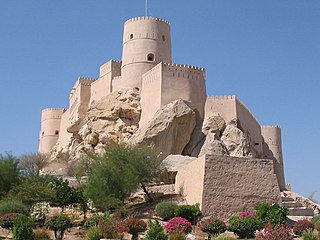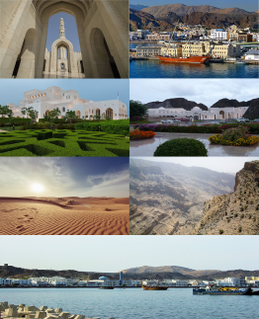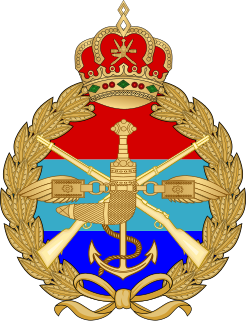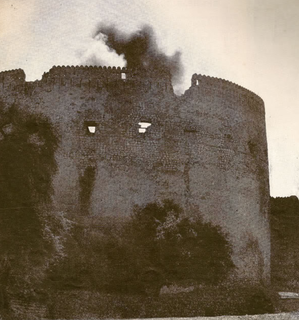
Oman, officially the Sultanate of Oman, is a country on the southeastern coast of the Arabian Peninsula in Western Asia. Located in a strategically important position at the mouth of the Persian Gulf, the country shares land borders with the United Arab Emirates to the northwest, Saudi Arabia to the west, and Yemen to the southwest, and shares marine borders with Iran and Pakistan. The coast is formed by the Arabian Sea on the southeast and the Gulf of Oman on the northeast. The Madha and Musandam exclaves are surrounded by the UAE on their land borders, with the Strait of Hormuz and the Gulf of Oman forming Musandam's coastal boundaries.

Oman is the site of pre-historic human habitation, stretching back over 100,000 years. The region was impacted by powerful invaders, including other Arab tribes, Portugal and Britain. Oman once possessed the island of Zanzibar, on the east coast of Africa as a colony.

Muscat is the capital and is the most populated city in Oman. It is the seat of the Governorate of Muscat. According to the National Centre for Statistics and Information (NCSI), the total population of Muscat Governorate was 1.4 million as of September 2018. The metropolitan area spans approximately 3,500 km2 (1,400 sq mi) and includes six provinces called wilayat. Known since the early 1st century CE as an important trading port between the west and the east, Muscat was ruled by various indigenous tribes as well as foreign powers such as the Persians, the Portuguese Empire, the Iberian Union and the Ottoman Empire at various points in its history. A regional military power in the 18th century, Muscat's influence extended as far as East Africa and Zanzibar. As an important port-town in the Gulf of Oman, Muscat attracted foreign tradesmen and settlers such as the Persians and the Balochis. Since the ascension of Qaboos bin Said as Sultan of Oman in 1970, Muscat has experienced rapid infrastructural development that has led to the growth of a vibrant economy and a multi-ethnic society. Muscat is termed as a Beta - Global City by the Globalization and World Cities Research Network.

Said bin Taimur was the 13th Sultan of Muscat and Oman from 10 February 1932 until he was deposed on 23 July 1970 by his son Qaboos bin Said.

Faisal bin Turki, GCIE, historic spelling Fessul bin Turkee, ruled as Sultan of Muscat and Oman from 4 June 1888 to 4 October 1913. He succeeded his father Turki bin Said as Sultan. Upon his death in 1913, he was succeeded by his eldest son Taimur bin Faisal.

The Sultan's Armed Forces are the Royal Army of Oman, Royal Navy of Oman, Royal Air Force of Oman, Sultan's Special Force and other defense forces of the Sultanate of Oman. Since their formal establishment in the early 1950s, with British assistance SAF has twice overcome insurgencies which have threatened the integrity or social structure of the state, and more recently have contributed contingents or facilities to coalitions formed to protect the Persian Gulf states.

Al-Wasik Billah al-Majid Sheikh Taimur bin Faisal bin Turki, KCIE, CSI was the sultan of Muscat and Oman from 5 October 1913 to 10 February 1932. He was born at Muscat and succeeded his father Faisal bin Turki, Sultan of Muscat and Oman as Sultan.

Ghalib bin Ali bin Hilal Alhinai was the last elected Imam (ruler) of the Imamate of Oman.

The Sultanate of Muscat and Oman was a state that encompassed the present-day Sultanate of Oman and parts of present-day United Arab Emirates and Gwadar, Pakistan. Muscat courts' verdicts were based on Ibadi Islamic sharia law and appeals were raised to the Sultan of Muscat, who exercised supreme ruling.

The Imamate of Oman refers to a historical area within the Oman proper in the present-day Al Hajar Mountains in Sultanate of Oman. The capital of the Imamate alternated historically between Rustaq and Nizwa. The Imamate's territory extended north to Ibri and south to Alsharqiyah region and the Sharqiya Sands. The Imamate was bounded from the east by the Al Hajar Mountains and from the west by the Rub' al Khali desert. The Al Hajar Mountains separated the Imamate of Oman from the Sultanate of Muscat. The elected Imam (ruler) resided in the capital, and Walis (governors) represented the Imamate in its different regions.

Al Buraimi Governorate is a governorate of Oman which was split from the Ad Dhahirah Region. Until October 2006, the area was part of Ad Dhahirah Region. At this time, the new governorate was created from the Wilayats (Provinces) of Al Buraymi and Mahdah. A third wilayat, As-Sunaynah, was created from parts of the two.

The House of Al Said is the ruling royal house of the Sultanate of Oman, and former ruling royal house of the Sultanate of Muscat and Zanzibar and the Sultanate of Zanzibar.

The Jebel Akhdar War or the Oman War, also known as Jebel Akhdar rebellion broke out in 1954 and again in 1957 in Oman, as an effort by the local Omanis in the interior of Oman led by their elected Imam, Ghalib Alhinai, to protect the Imamate of Oman from the occupation plans of sultan Said bin Taimur, backed by the British government, who were eager to gain access to the oil wells in the interior lands of Oman. Sultan Said received direct financing to raise an armed force to occupy the Imamate of Oman from Iraq Petroleum Company (IPC), a consortium of oil companies that was majorly owned by what is known today as Royal Dutch Shell, Total, ExxonMobil and British Petroleum (BP); the latter was majority-owned by the British government. The Imamate was eventually supported by Arab states. The war lasted until 1959, when the British armed forces decided to take on direct interventions using air and ground attacks on the Imamate, which won the Sultanate the war. The declarations signed by the sultans of Muscat to consult the British government on all important matters, the unequal trade treaties signed by the two sides favoring British interests, the cessation of the Omani Kuria Muria islands to the British, and the vast control over the Sultanate's government ministries, including defense and foreign affairs, exerted by the British rendered the Sultanate a de facto British colony. The UN General Assembly adopted the 'Question of Oman' resolution in 1965, 1966 and again in 1967 that called upon the British government to cease all repressive action against the locals, end British control over Oman and reaffirmed the inalienable right of the Omani people to self-determination and independence.
Hināwī are one of two major tribes of Oman and the Trucial Coast, the other being the Ghāfirī. Characterized as two significant factions having distinct interests and organizations, their rivalry began approximately 2000 years ago; almost during the time Ghafiris arrived to Oman. The Hinawis, for the most part, resided in southeast Oman, while the Ghafiris predominated in the northwestern part of Oman. Several tribal groups make up the Hinawi alliance, such as, the Dhowahir, Beni Yas, and the Awamir, Beni Hina and the Harasis. During the 18th century, serious conflicts occurred between the two factions. These conflicts only ended after many sub-tribes were united under one leader that belonged to one of the two factions. The Hinawis gathered under Khalaf bin Mubarak Alhinai from the Bani Hina tribe, while the Ghafiris gathered under Mohammed bin Nasir Alghafiri of the Beni Ghafir tribe. The almost equal strength of the two alliances led to the end of the feud. The rivalry played a decisive role in shaping the political history of Oman, with Omani tribes affiliating themselves historically with either the Ghafiri or Hinawi alliances.
Nasir bin Murshid was the founder of the Yaruba dynasty of Imams of Oman, a member of the Ibadi sect. He ruled from 1624 to 1649. He took power during a chaotic period when the former dynasty had collapsed and the interior of the country was lawless, while the Portuguese held the main coastal ports. In a series of campaigns he established his authority over the Omani tribes and expelled the Portuguese from most of their bases.
The 2016–17 Sultan Qaboos Cup is the 44th edition of the Sultan Qaboos Cup, the premier knockout tournament for football teams in Oman.
The Buraimi Dispute was a series of attempts to influence the loyalties of tribes and communities in and around the Buraimi Oasis in the 1940s and 1950s, which culminated in an armed conflict between forces and tribes loyal to Saudi Arabia, Oman and the Trucial States, which broke out as the result of a territorial dispute over the area of Tuwwam, today divided between the town of Al-Buraimi in Oman, and the city of Al Ain in the Eastern Region of the Emirate of Abu Dhabi, UAE. It amounted to an attempted Saudi invasion of the Buraimi Oasis. Its roots lay in the partitioning of tribal areas and communities which took place in the Trucial States when oil companies were seeking concessions to explore the interior.
The Muscat rebellion was an uprising in 1913 led by Sālim bin Rāshid al-Kharūṣī against the authority of the Sultans of Muscat and Oman. The rebels established their own state, the Ibāḍī imamate. Its causes lay in a deep-rooted rivalry between northern and southern tribes of Muscat and Oman. It began in May 1913 in Tanuf. On 5 June, the rebels captured Nizwa, and on 20 June they captured Izki. By this time, the rebels had also surrounded Samail. On 24 June, the rebels captured al-`Awabi. By July, the situation had gotten so dire that the British government sent a small garrison to Natrah to aid the sultan of Muscat, to no avail. In August, the rebels captured Samail. Also in August, the rebels launched an offensive towards the coastal side of al-Jabal al-Akhda, and Nakhl was besieged on the 4th. Nakhl ultimately fell at the beginning of April 1914, after the desertion of several of the imam's reinforcement contingents. In April 1914 the Royal Air Force bombed Barkah and Qaryat to deter rebel attacks on those settlements.

The Saudi Arabia–United Arab Emirates border is 457 km in length and runs from the Persian Gulf coast in the west to the tripoint with Oman in the east.














